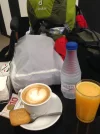I agree with Mark and some other posters. I carry 0.5L in my pocket and refill it when ever there is a source of fresh water. I also carry an empty 1.5L bottle in my pack for those day there is a possibility of no water and fill it in the morning for security sake.
Biarritz Don's answer comes closest to what has sort of become a default, at least for the
Camino Frances. In fact, many of us "veterans" consider the "official" water bottle of the Camino to be the ubiquitous .5 liter water bottle you buy full at the beginning, then rinse and reuse all the way to Santiago. If it gets damaged, grungy, or just no longer worthwhile, you recycle the old ones and buy new ones.
Please do recycle if possible and NEVER toss ANY trash along the Camino. Pack it out to the next rubbish bin.
This said, many people prefer to carry water bladders. I originally bought one to use with my Osprey Kestrel 48. However, once I learned that it weighed 11 oz when empty, I decided to sell it off. I switched to the "standard" discussed above and do not plan to switch. I respect everyone's right to have a preference. Many of us just think we figured out what works for most people, most of the time. Plus, there is no maintenance overhead, time or effort, with the ubiquitous .5 liter water bottle.
Most of us carry at least two of these smallish bottles. I carry four bottles, as I have a special diet with powders and rehydration salts that must be dissolved in water. So, two bottles are food-substitutes and two are for plain old water. Once empty and rinsed, the "food" bottles get refilled with plain water when I can. The others posting above are also right that refilling the two, .5 liter bottles is easy. Also, Don's idea about carrying the empty 1.5 liter bottle is a good one.
There are some stretches of the
Camino Frances, especially on the Meseta, where the local water table, and shallow wells are contaminated from decades of intensive farming. From Carrion de los Condes to Leon, you need to be careful to only use tap water at cafes, albergues or hotels. This seems to be where most of the complaints about contracting GI symptoms come from. The spring water, even inside towns, should be suspect in these areas. This year, I bought filled, 1.5 liter bottles at Carrion before I started out on this stretch. Don's idea of bringing your own bottle works as well.
Yes, water is heavy, but consider that short of death or another grievous accident, a nasty gastrointestinal disease is about the worst thing that can happen to you while you are trying to walk a Camino. This is especially true for the ladies. While there may be cafes every 5 Km or so, there are no facilities along the Camino, and you will be lucky to find a stand of bushes or trees for privacy on the Meseta. Plus, you consume water as you continue and your carried load will get lighter. You will also likely be sharing water with others who did not read this posting, refilling their smaller bottles.
I hope this helps.






















